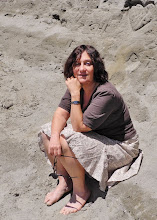 |
| photo by Sarah Talvi |
After printing out the score, we played through together, just out of curiosity, and to our delight found the Hermann version most satisfying. Suddenly, four part chords that are often forced or butchered by many violinists of today's era could be rendered with ease and elegance; the underlying harmonies are supported by the second violin with just the right touch of texture, and embellished with flourishes that, I believe, might have pleased old Bach himself. If nothing else, this two violin version of the Bach Chaconne by Hermann might be a godsend for the perplexed teacher, offering a strategy for pacing, polyphony and polish. I nudged my husband to quickly set up the recording equipment, as I know with oncoming holidays, one can put things off indefinitely. I also enlisted the aid of our youngest daughter Sarah as photographer.
It may be helpful to remember that Bach's music fell into relative obscurity after his death. It was Felix Mendelssohn who made Bach's works accessible to the wider public, perhaps rescuing him from oblivion; the general consensus at that time was that Johann Sebastian Bach was nothing more than a musical "mathematician". Mendelssohn published a piano accompaniment to the Chaconne in London and Hamburg in 1847, which was followed a few years later with the accompaniments for all six of Bach's Sonatas and Partitas for Solo Violin by Robert Schumann. I eagerly await the experience of studying these!
The venerable concertmaster of the Gewandhaus Orchestra in Leipzig, Ferdinand David, immortalized for his premiere of the Mendelssohn Violin Concerto, introduced the first edited publication of Bach's Sonatas and Partitas for Solo Violin. However, David was known to have remarked that "he would not be moved by any fee whatsoever to step onto a stage with a naked violin," so terrifying was the thought of performing these works alone. Joseph Joachim was the first daring soul to gather the courage to perform the works without accompaniment, and always did so, which set the standard for our modern day.
Friedrich Hermann, the editor of this two violin version of the Chaconne, was himself a student of Ferdinand David at the Leipzig Conservatory. He also studied composition with Moritz Hauptmann and Felix Mendelssohn.
Ilkka and I dedicate this home production to the memory of Veikko Talvi, who passed away at the age of 100 on October 9, 2011. My dear father-in-law, whose loving spirit will forever remain with us, treasured every note that we played. And then some.


